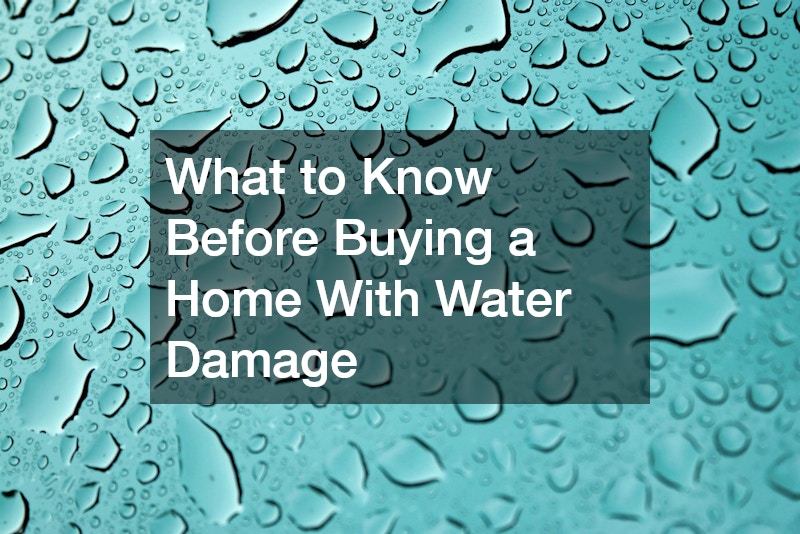Understanding the complexities and considerations of purchasing a home with water damage is crucial for potential buyers. This comprehensive guide will cover the origins, implications, and consequences of water damage and equip you with the knowledge needed to make an informed purchase. While homes with water issues can sometimes present opportunities for savings and investment, they can also carry hidden costs, long-term repairs, and safety concerns. Knowing what to look for, which professionals to consult, and how to assess the true condition of the property is essential before committing.
What Are the Common Causes of Water Damage in Homes?
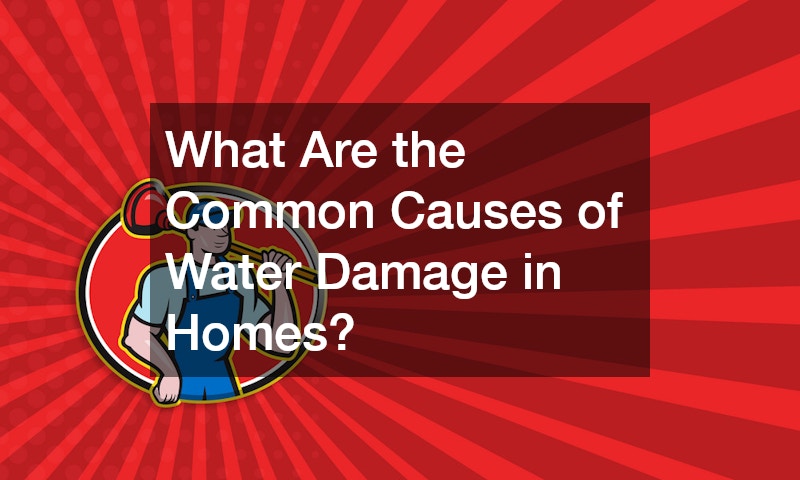
Weather-Related Issues
Weather events remain one of the top contributors to residential water damage. Heavy rainfall, snowmelt, hurricanes, and flash floods can overwhelm a home’s drainage infrastructure, especially if it lacks proper grading or storm water control. Homes located in flood-prone areas are particularly vulnerable and may require additional measures like sump pumps or elevated foundations. For buyers in these regions, it’s important to verify whether the home insurance plan covers flood-related damages, as not all policies include it by default.
Plumbing Failures
Failing pipes and aging plumbing systems are major causes of interior water damage. Whether it’s due to pipe corrosion, loose fittings, or improper installations, leaks can quickly escalate into significant problems. Hiring certified plumbers or a reputable plumbing company to inspect the entire system—including joints, connections, and valves—can help uncover hidden vulnerabilities. Water heater failures are also a common issue; a neglected water heater can burst or leak, leading to severe flooring and wall damage. Engaging a provider that offers water heater service can identify problems early and extend the unit’s lifespan.
Roof Leaks
Damaged, aging, or improperly installed roofs can allow water to infiltrate during storms. Signs like missing shingles, cracked flashing, or sagging rooflines may indicate the need for immediate repairs. Water that penetrates a roof can cause rot in the attic or insulation, creating the perfect environment for mold growth. If leaks are suspected, specialized leak detection services can pinpoint the source and help mitigate further issues before they escalate into structural problems.
Foundation Cracks
Cracks in the foundation may seem minor at first, but they can allow water to seep into basements or crawl spaces, especially during wet seasons. Over time, this can weaken the structural integrity of the home. Foundation water damage is often more expensive and complicated to repair, requiring assessment by structural engineers and waterproofing professionals. Buyers should ask about previous repairs and verify whether any claims were filed with the home insurance company for these issues.
Poor Drainage Systems
Poorly designed or clogged drainage systems around the exterior of the home can result in pooling water near the foundation. This creates a high risk of basement flooding or soil erosion. A qualified drain cleaning service can inspect and clear out gutters, downspouts, and exterior pipes to ensure efficient water diversion. Upgrading outdated systems or installing French drains can significantly reduce the risk of future water damage.
How to Identify Signs of Water Damage Before Buying?
Stains on Walls and Ceilings
Water stains, especially brown or rust-colored rings on drywall, are visible indicators of past or ongoing leaks. These can stem from ceiling leaks, plumbing issues, or appliance malfunctions. A professional leak detection team can use infrared imaging and moisture meters to determine if these spots are still active.
Musty Odors
Musty or damp odors signal the presence of mold or mildew, often found behind walls or under flooring. Even if no mold is visible, these smells suggest hidden moisture pockets. A water restoration company can provide detailed assessments and outline necessary remediation efforts to restore indoor air quality and safety.
Peeling Paint or Wallpaper
Water damage often causes bubbling, flaking, or peeling of paint and wallpaper. These cosmetic changes usually mean moisture has permeated the wall, possibly due to a leak or high humidity levels. If the affected area is near plumbing lines, a plumbing company can determine whether a nearby leak is to blame.
Warped or Buckled Floors
Hardwood or laminate floors that appear swollen, lifted, or warped may have absorbed significant moisture. Carpeted floors may also feel damp. These changes often result from plumbing leaks or water heater failures. A thorough inspection by a water heater service provider and plumbing experts can rule out appliance-related causes.
Presence of Mold or Mildew
Visible mold—often green, black, or white—can appear in corners, along baseboards, or inside cabinets. Mold not only damages materials but also poses health risks. Restoration professionals trained in mold remediation should be engaged to assess the extent of the infestation and propose long-term prevention methods.
How Does Water Damage Impact the Value of a Home?
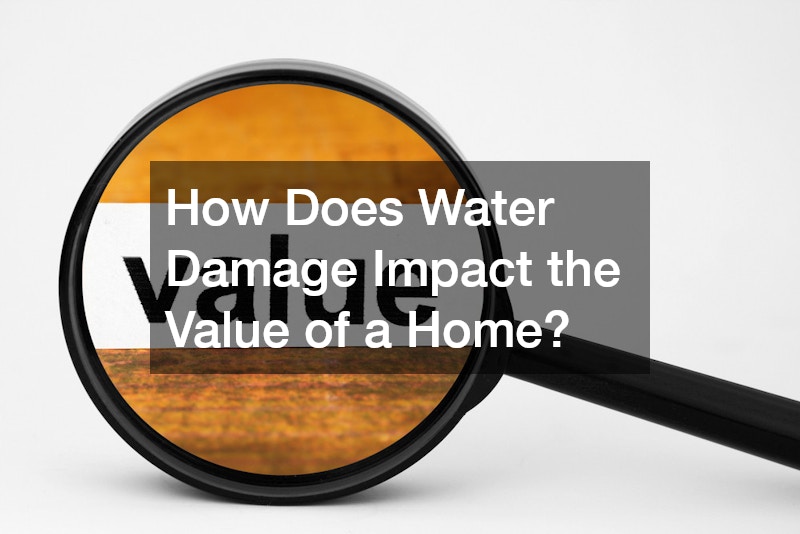
Reduction in Market Value
Water damage reduces a home’s appeal to most buyers, translating to a lower selling price. Even if repaired, the stigma of prior damage can deter offers or prolong time on the market. Properties with damage history often require additional inspections, and buyers may expect concessions.
Increased Insurance Premiums
If the home has a history of multiple water-related insurance claims, future premiums are likely to be higher. A home insurance company may label the home as a higher risk, especially if no preventative upgrades have been made. Buyers should shop for a comprehensive home insurance plan that includes water damage protection and understand any limitations on coverage.
Potential for Further Damage
Left unaddressed, water damage can compromise a home’s systems and lead to more costly repairs. Minor leaks can become major structural issues if they impact load-bearing walls or support beams. Consulting professionals like structural engineers, electricians, and plumbers can help determine the extent of ongoing risk.
Cost of Repairs and Restoration
The cost of fully restoring a water-damaged home often exceeds initial estimates. This includes expenses for drying equipment, demolition, mold treatment, and material replacement. A water restoration company can provide detailed scopes of work and timelines, which are critical in negotiating sale prices or estimating investment feasibility.
Negative Aesthetic Impact
Water stains, mold patches, and warped materials detract from the aesthetic appeal of a property. Even well-repaired homes may retain odors or uneven finishes, reducing perceived value. This aesthetic impact can also increase staging and renovation costs for buyers planning to resell.
What Are the Costs Involved in Repairing Water Damage?
Inspection Fees
Thorough inspections by professionals like home inspectors, electrical contractors, and water restoration specialists can cost several hundred dollars. These evaluations are essential in understanding the scope of damage and identifying safety concerns.
Immediate Repair Costs
Depending on severity, immediate fixes may involve plumbing repairs, replacing flooring, or repairing drywall. In homes with active leaks, emergency services from plumbers or a water restoration company may be needed to prevent worsening damage.
Long-term Maintenance Costs
Homes that have previously experienced water damage often require more frequent inspections and ongoing maintenance. This can include routine leak detection, regular servicing of the water heater, and inspections of basement waterproofing systems.
Mold Remediation Costs
Mold remediation is one of the most costly aspects of water damage repair. Professional services include containment, removal of affected materials, air filtration, and preventative treatments. Costs vary based on the type of mold and square footage affected.
Warranty and Insurance Considerations
Some repairs may be covered under a builder’s warranty or a third-party protection plan. It’s important to clarify what your home insurance covers and whether additional endorsements are needed for water backup or mold.
How Does Water Damage Affect Health and Safety?
Growth and Spread of Mold
Mold thrives in damp environments and can rapidly spread through ventilation systems. Inhalation of spores can cause allergies, asthma, and other respiratory issues. Professional mold remediation should be prioritized to ensure a safe living environment.
Structural Instability
Extended exposure to moisture can rot wood framing, compromise drywall, and erode foundations. Structural repairs often require engineers and licensed contractors to ensure the home meets safety standards.
Potential for Electrical Hazards
Water can cause short circuits, especially if it infiltrates outlets or junction boxes. Electrical contractors should be consulted to inspect wiring systems and ensure they are up to code after a flood or leak.
Allergies and Respiratory Issues
Damp environments support the growth of dust mites and other allergens. Poor indoor air quality caused by mold and bacteria can impact vulnerable occupants, including children and the elderly.
Pest Infestation Risks
Standing water and damp materials attract pests such as cockroaches, termites, and rodents. Eliminating moisture and sealing entry points is essential for pest prevention and mitigation.
Can Water Damage Be Properly Repaired?
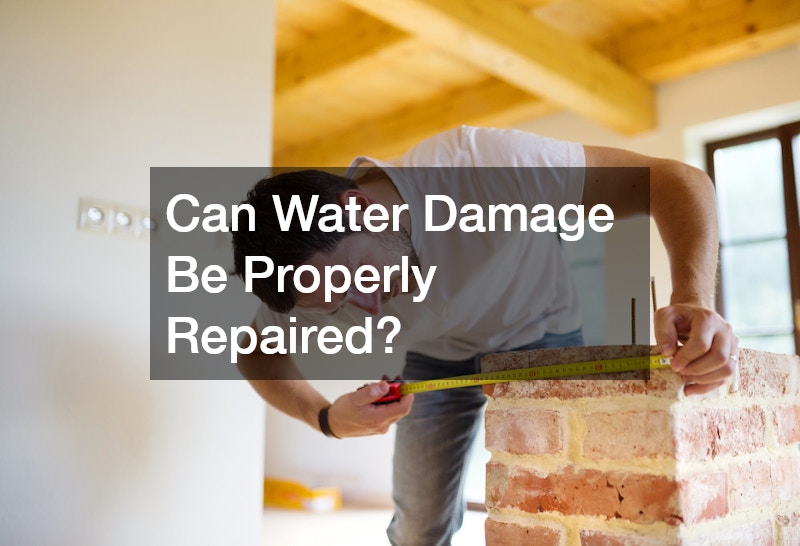
Role of Professional Restoration Services
A certified water restoration company plays a key role in rehabilitating water-damaged homes. Their services include water extraction, drying, mold removal, and structural repairs. Choosing a firm with experience and proper certification is essential for quality results.
Techniques for Repairing Structural Damage
Repairs may include replacing rotted beams, reinforcing damaged supports, and resealing affected areas. Techniques like epoxy injections and waterproof coatings may also be used, depending on the extent of the damage.
Mold Removal and Prevention Strategies
Effective mold removal includes identifying all affected areas, using HEPA filtration, and applying fungicidal treatments. Prevention strategies involve maintaining proper humidity, fixing leaks promptly, and scheduling regular inspections.
Long-term Monitoring and Maintenance
Once a property has been restored, long-term success depends on monitoring moisture levels and inspecting vulnerable areas. Annual inspections by leak detection specialists or plumbers can catch early signs of recurring issues.
Homeowner Repair vs. Hiring Professionals
DIY fixes may work for minor damage, but major issues should be handled by certified professionals. Plumbing companies, electrical contractors, and water restoration firms have the expertise to complete repairs safely and in compliance with building codes.
How to Negotiate the Price When Buying a Water-Damaged Home?
Conducting a Thorough Home Inspection
Inspections should go beyond the surface and include evaluations by plumbers, electricians, and moisture detection specialists. These findings form the basis for any price negotiation or contingency request.
Estimating the Cost of Repairs
Getting multiple quotes from a plumbing company, water restoration company, and electrical contractors helps buyers understand the total cost of repairs. This allows for more accurate budgeting and stronger negotiating leverage.
Evaluating Market Comparables
Buyers should examine nearby properties without water damage to understand how much the damage is impacting the asking price. This comparison can support a reduced offer.
Discussing Concessions and Contingencies
Negotiating for seller-funded repairs, price reductions, or closing credits can make a water-damaged home more financially viable. Include inspection and repair contingencies in any purchase contract to protect your investment.
Seeking Professional Advice and Appraisals
Real estate agents, appraisers, and attorneys can provide valuable insights into how water damage affects value and whether the deal aligns with your financial goals.
What Are the Insurance Implications for Water-Damaged Homes?
Understanding Homeowner Insurance Coverage
A standard home insurance policy may not cover all types of water damage. Buyers should review the scope of their home insurance plan to determine coverage limits, exclusions, and deductibles.
Filing Claims for Water Damage
Buyers should verify whether previous owners filed any water damage claims. Multiple claims may limit coverage options or increase premiums under a new home insurance policy.
Comparing Insurance Options and Policies
Shopping around for home insurance that includes water backup and mold remediation can save money and provide peace of mind. Consider bundling services or adding endorsements if the home is in a high-risk area.
Assessing Risk and Uninsurable Conditions
Some properties may be uninsurable if they have a history of severe water damage or reside in high-risk zones. A thorough understanding of coverage limitations is essential.
Impacts on Future Insurance Premiums
Even with repairs, insurers may view the property as a higher risk. Buyers should anticipate higher premiums and weigh this into their overall cost of ownership.
What Legal Considerations Should Be Taken into Account?
Disclosure Laws and Seller Obligations
Sellers are typically required by law to disclose known defects, including water damage. Buyers should obtain these disclosures in writing and verify their accuracy during the inspection process.
Consequences of Nondisclosure
If water damage was concealed or not disclosed, buyers may pursue legal action. Remedies can include repair compensation or rescission of the sale.
Legal Recourse for Hidden Damages
If hidden damages are discovered post-purchase, buyers should consult an attorney to explore legal options. Documentation from inspections and repair professionals strengthens any potential claim.
Role of Real Estate Agents and Contracts
Agents should help ensure that contracts include the proper clauses for repair responsibilities and disclosures. Buyers should work with experienced professionals who are familiar with water damage cases.
Understanding Local Regulations and Ordinances
Local building codes may require permits or inspections before water damage repairs can proceed. Buyers should ensure that any previous work was done legally and to code.
Should You Buy a Home with Water Damage?
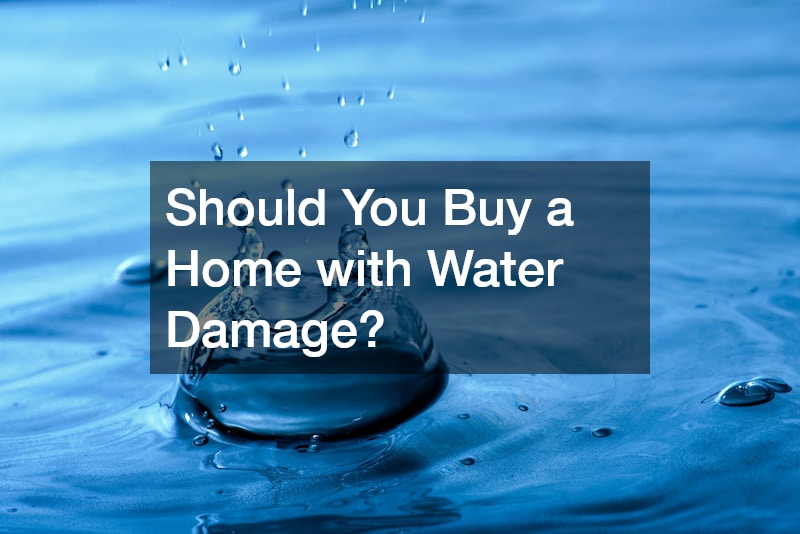
Weighing Risks vs. Benefits
A water-damaged home can be a good deal for buyers willing to invest time and money into repairs. However, it also carries financial and health risks if not properly addressed.
Financial Feasibility Analysis
Consider whether the total costs, including insurance, repairs, and inspections, align with your budget. Consult financial advisors to understand the long-term viability of the purchase.
Long-term Investment Potential
With proper repairs, a water-damaged home in a desirable location can become a high-return investment. Track market trends and forecast appreciation before deciding.
Consideration of Location and Market Trends
Homes in strong real estate markets may warrant the investment, while those in stagnant or declining areas may pose greater financial risks.
Personal Risk Tolerance and Preferences
Some buyers may see value in taking on a project, while others prefer move-in-ready properties. The choice ultimately comes down to your comfort with risk and your capacity to manage renovations.
Closing Thoughts
Purchasing a home with water damage requires due diligence, research, and professional guidance. From hiring the right plumbers and electrical contractors to securing the right home insurance plan, buyers must take every precaution to protect their investment. With careful planning, expert advice, and thorough inspections, it is possible to transform a damaged property into a secure and valuable home.
